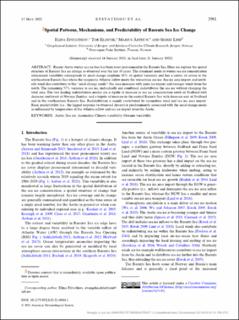| dc.contributor.author | Efstathiou, Evangelia | |
| dc.contributor.author | Eldevik, Tor | |
| dc.contributor.author | Årthun, Marius | |
| dc.contributor.author | Lind, Sigrid | |
| dc.date.accessioned | 2023-03-01T14:35:40Z | |
| dc.date.available | 2023-03-01T14:35:40Z | |
| dc.date.created | 2022-06-28T10:02:07Z | |
| dc.date.issued | 2022 | |
| dc.identifier.issn | 0894-8755 | |
| dc.identifier.uri | https://hdl.handle.net/11250/3055081 | |
| dc.description.abstract | Recent Arctic winter sea ice loss has been most pronounced in the Barents Sea. Here we explore the spatial structure of Barents Sea ice change as observed over the last 40 years. The dominant mode of winter sea ice concentration interannual variability corresponds to areal change (explains 43% of spatial variance) and has a center of action in the northeastern Barents Sea where the temperate Atlantic inflow meets the wintertime sea ice. Sea ice area import and northerly wind also contribute to this “areal-change mode”; the area increases with more ice import and stronger winds from the north. The remaining 57% variance in sea ice, individually and combined, redistributes the sea ice without changing the total area. The two leading redistribution modes are a dipole of increase in sea ice concentration south of Svalbard with decrease southwest of Novaya Zemlya, and a tripole of increase in the central Barents Sea with decrease east of Svalbard and in the southeastern Barents Sea. Redistribution is mainly contributed by anomalous wind and sea ice area import. Basic predictability (i.e., the lagged response to observed drivers) is predominantly associated with the areal-change mode as influenced by temperature of the Atlantic inflow and sea ice import from the Arctic. | en_US |
| dc.language.iso | eng | en_US |
| dc.publisher | AMS | en_US |
| dc.rights | Navngivelse 4.0 Internasjonal | * |
| dc.rights.uri | http://creativecommons.org/licenses/by/4.0/deed.no | * |
| dc.subject | Sjøis | en_US |
| dc.subject | Sea ice | en_US |
| dc.subject | Arktis | en_US |
| dc.subject | Arctic | en_US |
| dc.subject | Klimavariasjoner | en_US |
| dc.subject | Climate variability | en_US |
| dc.subject | Hav | en_US |
| dc.subject | Oceans | en_US |
| dc.title | Spatial Patterns, Mechanisms, and Predictability of Barents Sea Ice Change | en_US |
| dc.type | Journal article | en_US |
| dc.type | Peer reviewed | en_US |
| dc.description.version | publishedVersion | en_US |
| dc.rights.holder | Copyright 2022 American Meteorological Society | en_US |
| cristin.ispublished | true | |
| cristin.fulltext | original | |
| cristin.qualitycode | 2 | |
| dc.identifier.doi | 10.1175/JCLI-D-21-0044.1 | |
| dc.identifier.cristin | 2035645 | |
| dc.source.journal | Journal of Climate | en_US |
| dc.source.pagenumber | 2961-2973 | en_US |
| dc.relation.project | Norges forskningsråd: 263223 | en_US |
| dc.relation.project | Trond Mohn stiftelse: BFS2018TMT01 | en_US |
| dc.relation.project | Norges forskningsråd: 270733 | en_US |
| dc.relation.project | Norges forskningsråd: 276730 | en_US |
| dc.relation.project | EC/H2020/727852 | en_US |
| dc.subject.nsi | VDP::Oseanografi: 452 | en_US |
| dc.subject.nsi | VDP::Oceanography: 452 | en_US |
| dc.identifier.citation | Journal of Climate. 2022, 35 (10), 2961-2973. | en_US |
| dc.source.volume | 35 | en_US |
| dc.source.issue | 10 | en_US |

